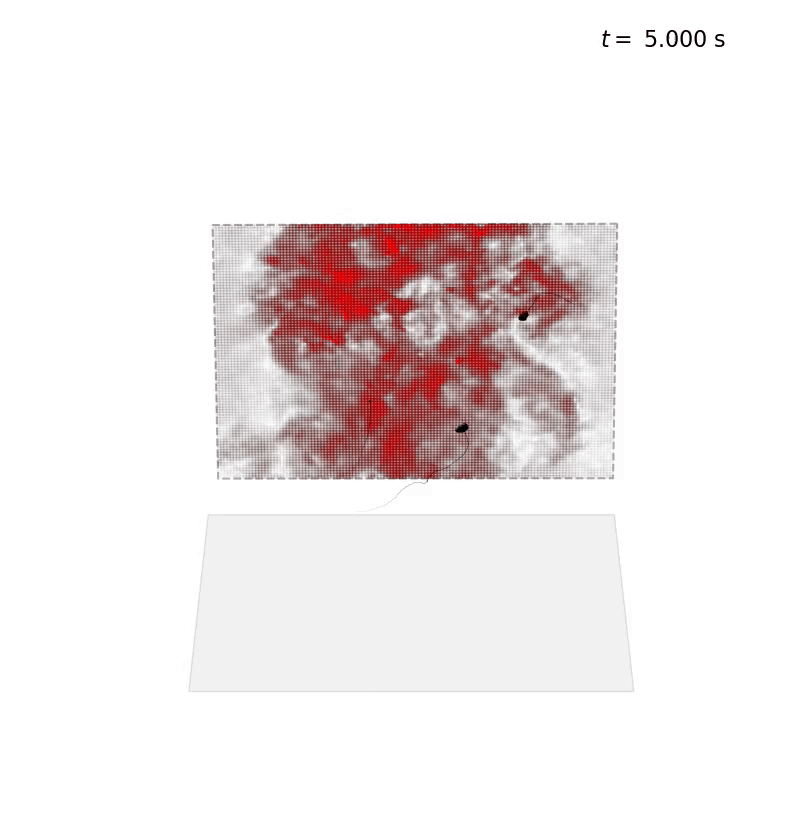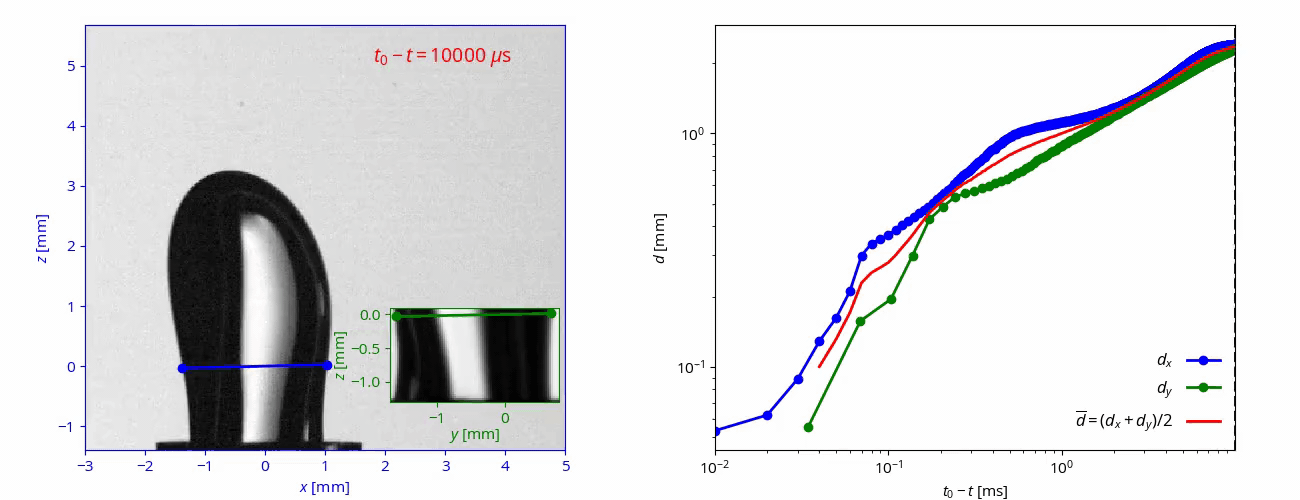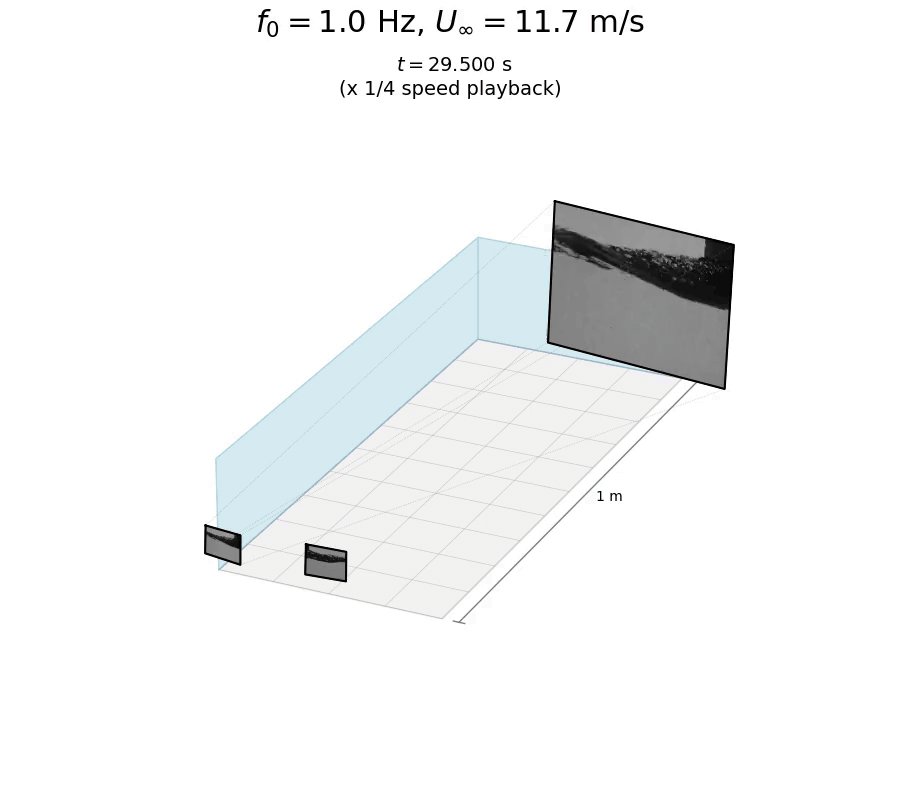Daniel Ruth

Postdoctoral Researcher at ETH Zurich
fluid mechanics | multiphase flows | turbulence | experimental methods
Research
About Me
Code
Google Scholar | LinkedIn | Github | CV
Research
I am a Postdoctoral Researcher in the Coletti Group, which is part of the Institute of Fluid Dynamics at ETH Zurich. During my PhD, I studied the dynamics of gas bubbles in turbulence in the Deike Lab at Princeton University, with applications to gas transfer at the ocean surface.
Broadly, I am interested in multiphase turbulent flows and the experimental and numerical techniques used to study them.
Turbulence near free surfaces
A free surface such as the ocean-atmosphere interface will modify the structure of a turbulent flow, and wind acting at a free surface can generate turbulence in the water below.
I study free surfaces experimentally: on the left in the animation below, homogeneous turbulence is generated in the bulk of a liquid by arrays of randomly-actuated synthetic jets; on the right, wind blown along the water surface in a long channel induces both surface gravity waves and turbulence in the water. In both setups, particle image velocimetry is used to obtain the vorticity fields (shown in red and blue), and laser-induced fluorescence is used to locate the air-water interface (shown in cyan).

Turbulent break-up of bubbles
In a turbulent flow, bubbles will break apart due to stresses from the surrounding turbulent liquid if they are large enough that surface tension is incapable of preventing severe deformations. Knowledge of the dynamics of the break-ups and the distribution of bubble sizes that are produced is important to modeling bubble-mediated gas transfer, as occurs with breaking waves on the ocean and in industrial bubble column reactors.

Related publications
- Ruth, D., Aiyer, A., Rivière, A., Perrard, S., and Deike, L. (2022). Experimental observations and modeling of sub-Hinze bubble production by turbulent bubble break-up. Journal of Fluid Mechanics, 951, A32.
- Rivière, A., Ruth, D. J., Mostert, W., Deike, L., & Perrard, S. (2022). Capillary driven fragmentation of large gas bubbles in turbulence. Physical Review Fluids, 7(8), 083602.
Bubble rise dynamics in turbulence
The speed at which bubbles rise through turbulence affects the time available for their gases to diffuse into the surrounding liquid. We studied this using stereoscopic imaging of bubbles in a laboratory turbulent flow (shown below) and point-particle simulations of bubbles in homogeneous, isotropic turbulence.

Related publications
- Ruth, D. J., Vernet, M., Perrard, S., & Deike, L. (2021). The effect of nonlinear drag on the rise velocity of bubbles in turbulence. Journal of Fluid Mechanics, 924.
Pinch-off of air bubbles deformed by tubulence
Bubbles broken apart by turbulence can adopt significantly deformed shapes during the break-up process. Here, we showed that turbulent deformations to a bubble pinching off from a needle can persist throughout the pinch-off process, even when the scale of the collapsing neck shrinks below the turbulent scales.

Related publications
- Ruth, D. J., Mostert, W., Perrard, S., & Deike, L. (2019). Bubble pinch-off in turbulence. Proceedings of the National Academy of Sciences, 116(51), 25412-25417.
Air entrainment by breaking waves
Breaking waves entrain air bubbles under the ocean surface, which enhance the flux of mass between the ocean and atmosphere. We studied air entrainment in a wind-wave channel (in which water waves are created by the combined action of a mechanical wavemaker and air blowing over the water surface). The video below shows a three-dimensional reconstruction of the bubble trajectories underwater, obtained with the images recorded from two side-by-side cameras shown in the foreground (one of which is enlarged for clarity in the background).

Related publications
- Ruth, D. J., Néel, B., Erinin, M. A., Mazzatenta, M., Jaquette, R., Veron, F., & Deike, L. (2022). Three‐dimensional measurements of air entrainment and enhanced bubble transport during wave breaking. Geophysical Research Letters, e2022GL099436.
- Erinin, M. A., Néel, B., Ruth, D. J., Mazzatenta, M., Jaquette, R. D., Veron, F., & Deike, L. (2022). Speed and Acceleration of Droplets Generated by Breaking Wind‐Forced Waves. Geophysical Research Letters, 49(13), e2022GL098426.